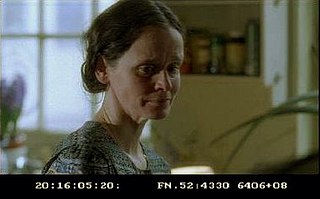 W
WFilm editing is both a creative and a technical part of the post-production process of filmmaking. The term is derived from the traditional process of working with film which increasingly involves the use of digital technology.
 W
WThe 30-degree rule is a basic film editing guideline that states the camera should move at least 30 degrees relative to the subject between successive shots of the same subject. If the camera moves less than 30 degrees, the transition between shots can look like a jump cut—which could jar the audience and take them out of the story. The audience might focus on the film technique rather than the narrative itself.
 W
WIn filmmaking, the 180-degree rule is a basic guideline regarding the on-screen spatial relationship between a character and another character or object within a scene. By keeping the camera on one side of an imaginary axis between two characters, the first character is always frame right of the second character. Moving the camera over the axis is called jumping the line or crossing the line; breaking the 180-degree rule by shooting on all sides is known as shooting in the round.
 W
WIn film and television production, B-roll, B roll, B-reel or B reel is supplemental or alternative footage intercut with the main shot. The term A-roll, referring to main footage, has fallen out of use.
 W
WCutting on action or matching on action refers to film editing and video editing techniques where the editor cuts from one shot to another view that matches the first shot's action.
 W
WIn the post-production process of film editing and video editing, a dissolve is a type of film transition in which one sequence fades over another. The terms fade-out and fade-in are used to describe a transition to and from a blank image. This is in contrast to a cut, where there is no such transition. A dissolve overlaps two shots for the duration of the effect, usually at the end of one scene and the beginning of the next, but may be used in montage sequences also. Generally, but not always, the use of a dissolve is held to indicate that a period of time has passed between the two scenes. Also, it may indicate a change of location or the start of a flashback.
 W
WThe DraCo, also known as DraCo Vision in one of its later models, was a non-linear video editing workstation created by MacroSystem Computer GmbH in 1994, based on the Commodore-Amiga platform.
 W
WAn establishing shot in filmmaking and television production sets up, or establishes, the context for a scene by showing the relationship between its important figures and objects. It is generally a long or extreme-long shot at the beginning of a scene indicating where, and sometimes when, the remainder of the scene takes place.
 W
WEvercast is a privately held software as a service company that makes collaborative software primarily for the film, television, and other creative industry sectors. Its platform allows remotely located creative teams to collaborate in real-time on video production tasks, such as reviewing dailies, editing footage, sound mixing, animation, visual effects, and other components simultaneously. Its primary users are directors, editors, VFX artists, animators, and sound teams in the film, television, advertising, and video gaming industries.
 W
WFast cutting is a film editing technique which refers to several consecutive shots of a brief duration. It can be used to quickly convey much information, or to imply either energy or chaos. Fast cutting is also frequently used when shooting dialogue between two or more characters, changing the viewer's perspective to either focus on the reaction of another character's dialog, or to bring to attention the non-verbal actions of the speaking character.
 W
WFilm editing is both a creative and a technical part of the post-production process of filmmaking. The term is derived from the traditional process of working with film which increasingly involves the use of digital technology.
 W
WA film transition is a technique used in the post-production process of film editing and video editing by which scenes or shots are combined. Most commonly this is through a normal cut to the next shot. Most films will also include selective use of other transitions, usually to convey a tone or mood, suggest the passage of time, or separate parts of the story. These other transitions may include dissolves, L cuts, fades, match cuts, and wipes.
 W
WA flatbed editor is a type of machine used to edit film for a motion picture.
 W
WA jump cut is a cut in film editing in which a single continuous sequential shot of a subject is broken into two parts, with a piece of footage being removed in order to render the effect of jumping forward in time. Camera positions of the subject in the remaining pieces of footage of the sequence should vary only slightly in order to achieve the effect. It is a manipulation of temporal space using the duration of a single shot, and fracturing the duration to move the audience ahead. This kind of cut abruptly communicates the passing of time as opposed to the more seamless dissolve heavily used in films predating Jean-Luc Godard's Breathless, which made extensive use of jump cuts and popularized the technique during the 1960s. For this reason, jump cuts are considered a violation of classical continuity editing, which aims to give the appearance of continuous time and space in the story-world by de-emphasizing editing, but are sometimes nonetheless used for creative purposes. Jump cuts tend to draw attention to the constructed nature of the film. More than one jump cut is sometimes used in a single sequence.
 W
WKeykode is an Eastman Kodak Company advancement on edge numbers, which are letters, numbers and symbols placed at regular intervals along the edge of 35 mm and 16 mm film to allow for frame-by-frame specific identification. It was introduced in 1990.
 W
WmimoLive is a live video production software developed and published by Boinx Software International GmbH, a German software company that specializes in applications for macOS and iOS. First launched in 2016, mimolive is the successor of BoinxTV first launched in 2008. It is geared towards professional video live switching and broadcasting software.
 W
WA Moviola is a device that allows a film editor to view a film while editing. It was the first machine for motion picture editing when it was invented by Iwan Serrurier in 1924. The Moviola company is still in existence and is located in Hollywood, where part of the facility is located on one of the original Moviola factory floors.
 W
WNon-linear editing is a form of offline editing for audio, video, and image editing. In offline editing, the original content is not modified in the course of editing. In non-linear editing, edits are specified and modified by specialized software. A pointer-based playlist, effectively an edit decision list (EDL), for video and audio, or a directed acyclic graph for still images, is used to keep track of edits. Each time the edited audio, video, or image is rendered, played back, or accessed, it is reconstructed from the original source and the specified editing steps. Although this process is more computationally intensive than directly modifying the original content, changing the edits themselves can be almost instantaneous, and it prevents further generation loss as the audio, video, or image is edited.
 W
WA point of view shot is a short film scene that shows what a character is looking at. It is usually established by being positioned between a shot of a character looking at something, and a shot showing the character's reaction. The technique of POV is one of the foundations of film editing.
A sound follower, also referred to as separate magnetic, sepmag, magnetic film recorder, or mag dubber, is a device for the recording and playback of film sound that is recorded on magnetic film. This device is locked or synchronized with the motion picture film containing the picture. It operates like an analog reel-to-reel audio tape recording, but using film, not magnetic tape. The unit can be switched from manual control to sync control, where it will follow the film with picture.
 W
WSteenbeck is a company that manufactures flatbed editors. Steenbeck is brand name that has become synonymous with a type of flatbed film editing suite which is usable with both 16 mm and 35 mm optical sound and magnetic sound film.
 W
WA two shot is a type of shot in which the frame encompasses two people. The subjects do not have to be next to each other, and there are many common two shots which have one subject in the foreground and the other subject in the background.
 W
WVideo editing is the manipulation and arrangement of video shots. Video editing is used to structure and present all video information, including films and television shows, video advertisements and video essays. Video editing has been dramatically democratized in recent years by editing software available for personal computers. Editing video can be difficult and tedious, so several technologies have been produced to aid people in this task. Pen based video editing software was developed in order to give people a more intuitive and fast way to edit video.
 W
WIn filmmaking, a wipe is a type of film transition where one shot replaces another by travelling from one side of the frame to another or with a special shape. If the wipe proceeds from two opposite edges of the screen toward the center or vice versa, it is known as a barn door wipe.
 W
WA workprint is a rough version of a motion picture, used by the film editor(s) during the editing process. Such copies generally contain original recorded sound that will later be re-dubbed, stock footage as placeholders for missing shots or special effects, and animation tests for in-production animated shots or sequences.